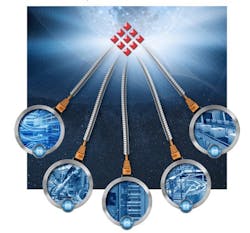Whether you’re ready for Industry 4.0 and the Industrial Internet of Things (IIoT) or not, technology suppliers are ramping up their cloud services offerings in a big way. One of the more recent announcements in this area comes from ProSoft Technology, a supplier of industrial communication products.
The company’s new product is called ProSoft Connect—which ProSoft describes as a secure, cloud-native platform for the Industrial Internet of Things that allows users to remotely access ProSoft’s ICX35 industrial cellular gateways.
While the remote access functionality ProSoft Connect delivers is an example of the rapidly expanding arena of industrial remote access platforms — the architecture underlying ProSoft Connect highlights the increasing use of IT technologies for industrial applications. This architecture is referred to as a container and microservices cloud architecture.
Keith Blodorn, director of ProSoft Technology’s wireless program, describes the architecture as follows: “Containers and microservices are terms used to describe an approach to developing applications for use in a cloud environment. The term container brings to mind a shipping container—a standardized box used in shipping to make it easier to move products overseas, through ports and across railways. In cloud application development, a container is a standardized set of services that support the application running inside the container and provide connection to the cloud host environment. Microservices are the applications that run inside the containers. As opposed to writing a single, monolithic program to deliver all user functions, developers build microservices to perform a very specific task. Various microservices come together to form what appears to the user as a complete cloud-based service. Yet, since each microservice and the container it resides in is fully self-sufficient, these functions are not dependent on each other.”
Stressing the fact that industrial end users don’t need to understand the details behind containers and microservices, Blodorn notes that a key takeaway for users is the stability this architecture provides to the industrial cloud-based applications on which they increasingly depend. To explain the architecture’s stability, he said it helps to understand the concept if you think about container programming as functions in Microsoft Word. For example, consider the ‘save’ function in Word. That function would be one container program.
"The container programming approach is to put discrete functions—such as ‘save’ or ‘text editing’ into separate containers,” Blodorn says. “That way if one fails, you don't have to reboot the whole program—just that function. The approach modularizes a platform.”
Since the containers and microservices architecture is a programming tool and not a communications protocol, the only people who need to know much about the architecture—aside from platform developers, of course—are system integrators. “Integrators who want to deliver certain functionalities via the cloud would need to under this architecture, because containers and microservices are like a Lego block approach to plugging into other services. It speeds the cooperation between different cloud service providers,” says Blodorn.
He clarified that containers and microservices are different from APIs (application programming interfaces) in that “an API is a schema—you send me X and I’ll send you Y. With containers and microservices you're running the actual functionality in the cloud. In ProSoft Connect, we have three copies of a program—like our VPN tunnel service—running at all times. One of which is the one being used, another is used as a backup, and the other is a redundant copy. With this approach, if there is any failover, it is invisible to the user. We’ll see it on the backend report for analysis and correction.”
Read the ProSoft Technology whitepaper that details the containers and microservices architecture.
For more Automation World coverage of how IT is increasingly being applied in industrial devices and applications, see the following articles:

